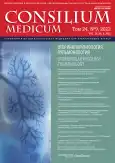Ways of penetration of glucocorticosteroids from the tympanic cavity to the structures of the inner ear: A review
- Authors: Blinova M.L.1, Golovanov A.E.2, Isachenko V.S.1
-
Affiliations:
- Saint-Petersburg Research Institute of Ear, Throat, Nose and Speech
- Kirov Military Medical Academy
- Issue: Vol 24, No 9 (2022)
- Pages: 626-631
- Section: Articles
- URL: https://journals.rcsi.science/2075-1753/article/view/120387
- DOI: https://doi.org/10.26442/20751753.2022.9.201907
- ID: 120387
Cite item
Full Text
Abstract
To date, in domestic and foreign literature, there are more and more reports of the successful use of glucocorticosteroids for the treatment of pathology of the inner ear by local – intratympanic administration. Many methods are being developed to deliver drugs to the structures of the inner ear. As you know, the systemic administration of glucocorticosteroids has a number of contraindications and a large number of side effects, due to a wide spectrum of action. Exogenous glucocorticoids disrupt the natural balance of the hypothalamic-pituitary-adrenal system, interfering with the negative feedback regulation system, which requires a long time to fully restore. The intratympanic method of administering glucocorticosteroids makes it possible to bypass the above undesirable effects and at the same time provide the desired therapeutic effect on the vestibular and cochlear structures of the inner ear. With regard to the effect on the structures of the inner ear, intratympanic use of glucocorticosteroids turned out to be more effective than the systemic one, which is associated with the presence of a hematoperilymphatic barrier, comparable in its permeability to the blood-brain barrier. Moreover, when administered systemically, large doses of steroids are required to achieve a sufficient concentration of the drug in the fluids of the inner ear. To date, many questions remain regarding the routes by which the drug penetrates to the structures of the inner ear, the principles of distribution of the drug within the cochlear fluids, as well as the anatomical obstacles that may be encountered on the way to achieving the desired therapeutic effect. The purpose of this article is to highlight the current achievements in the field of research on the routes of penetration of drugs, in particular glucocorticosteroids, to the structures of the inner ear from the tympanic cavity.
Full Text
##article.viewOnOriginalSite##About the authors
Marina L. Blinova
Saint-Petersburg Research Institute of Ear, Throat, Nose and Speech
Author for correspondence.
Email: m.blinova@niilor.ru
ORCID iD: 0000-0002-2163-7524
Res. Assist.
Russian Federation, Saint PetersburgAndrei E. Golovanov
Kirov Military Medical Academy
Email: lor_vma@mail.ru
ORCID iD: 0000-0001-7277-103X
Cand. Sci. (Med.), Assoc. Prof.
Russian Federation, Saint PetersburgVadim S. Isachenko
Saint-Petersburg Research Institute of Ear, Throat, Nose and Speech
Email: 3162256@mail.ru
ORCID iD: 0000-0001-9090-0413
D. Sci. (Med.), Assoc. Prof.
Russian Federation, Saint PetersburgReferences
Supplementary files







